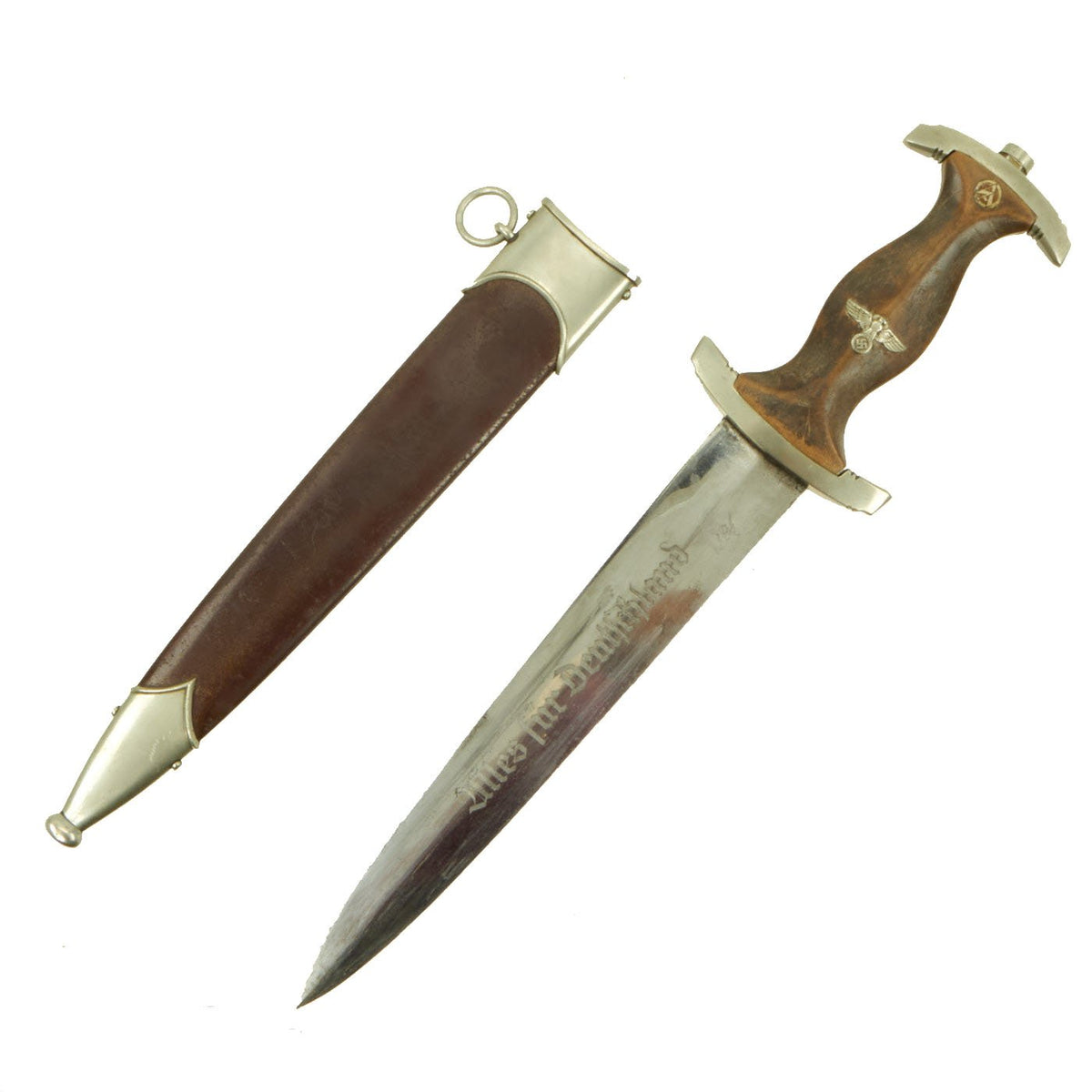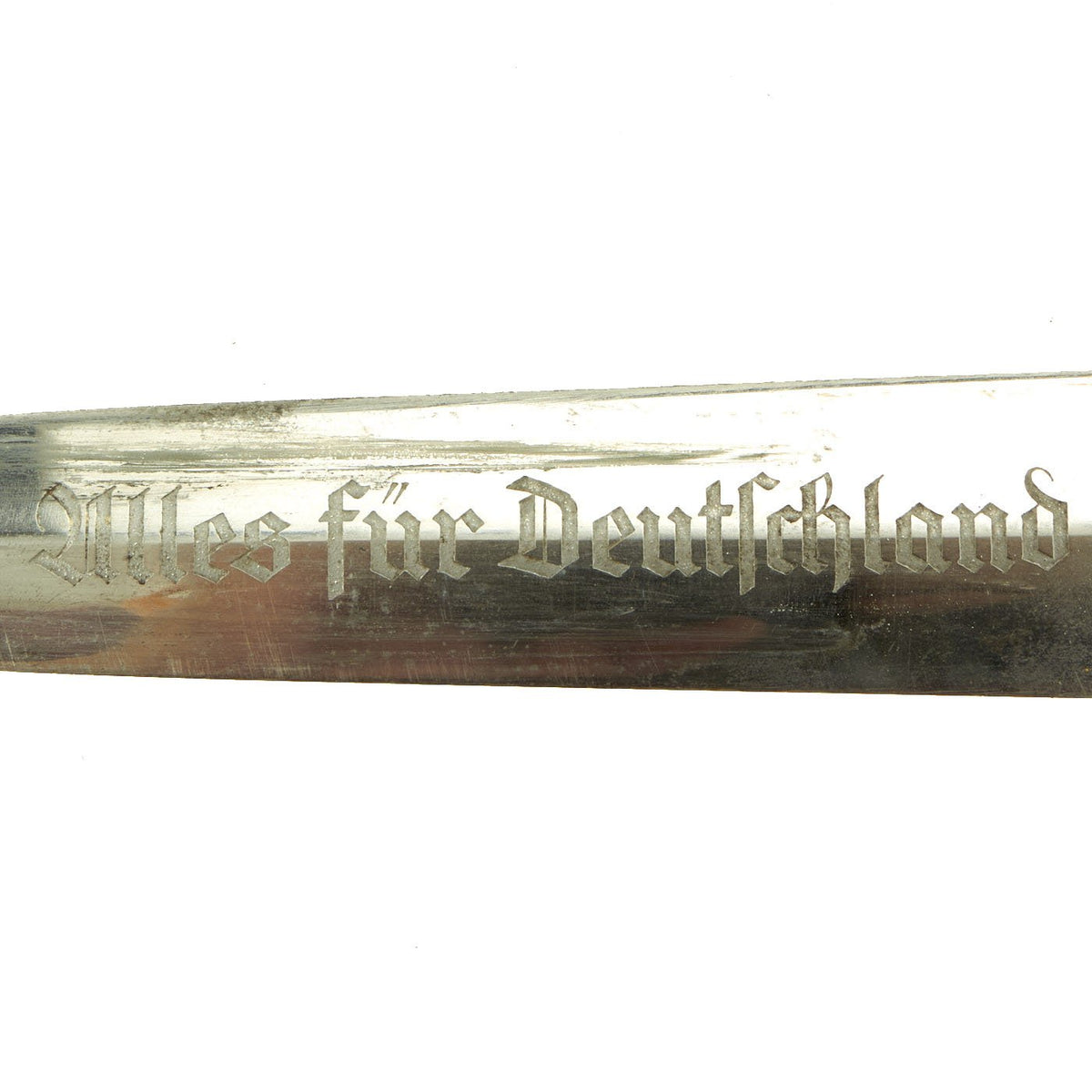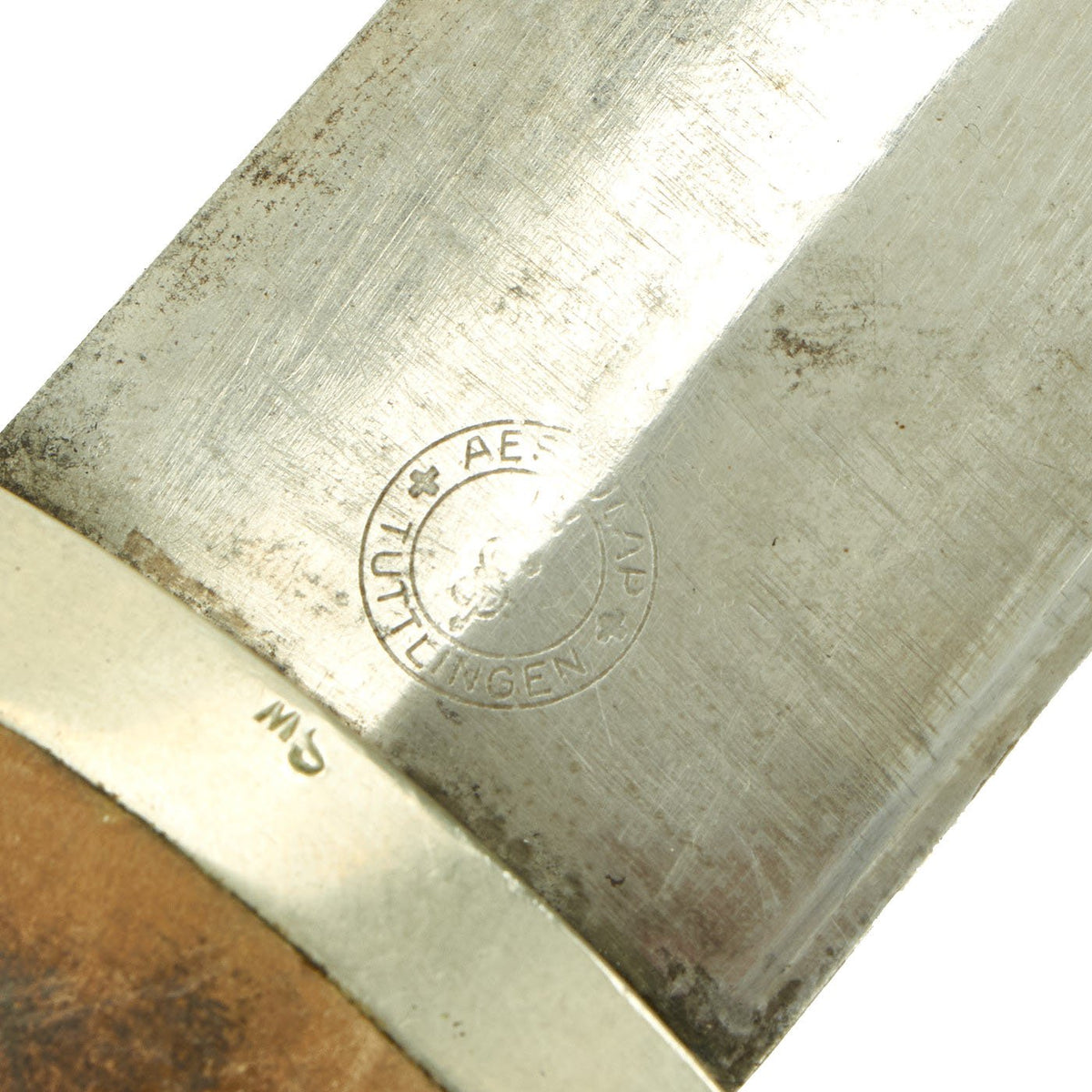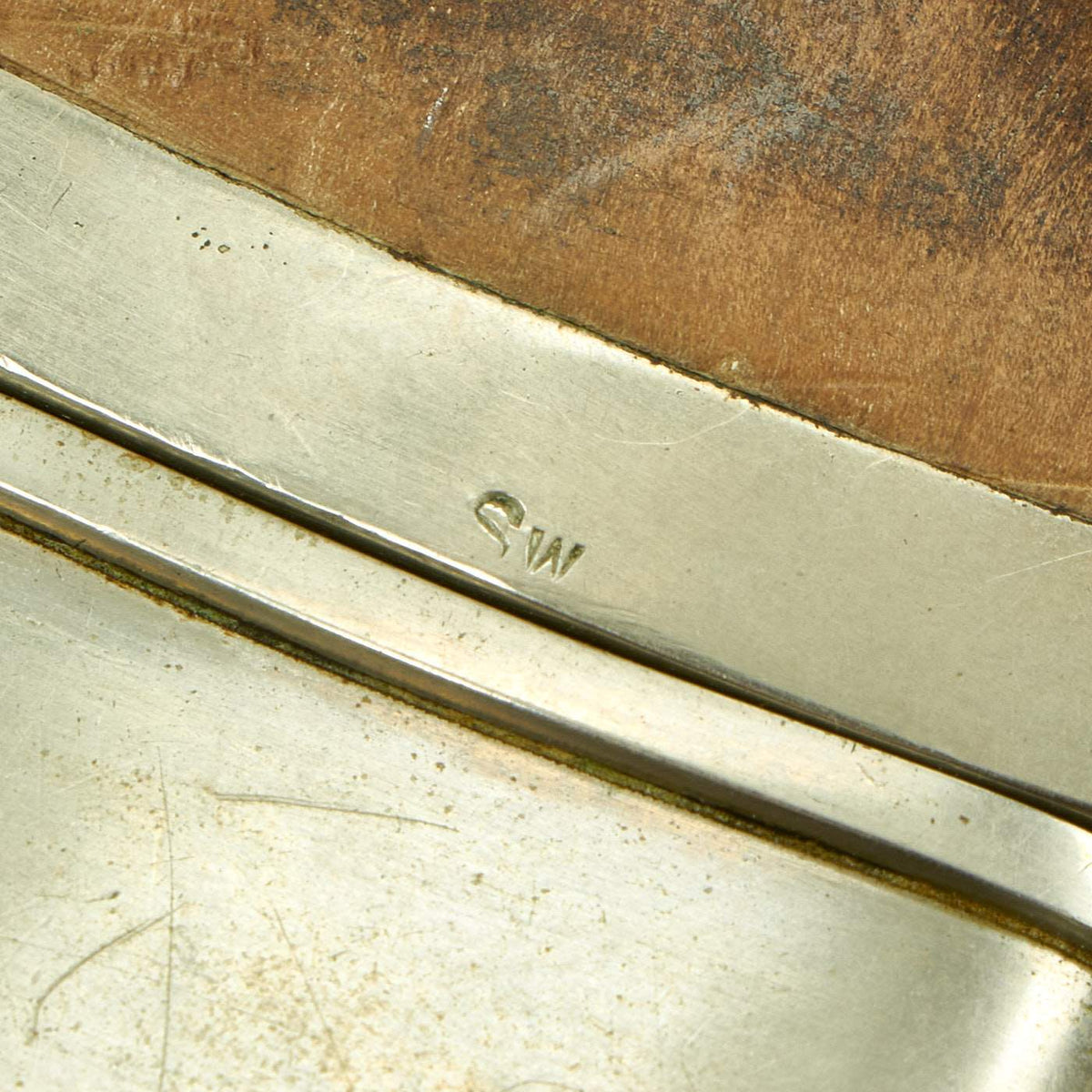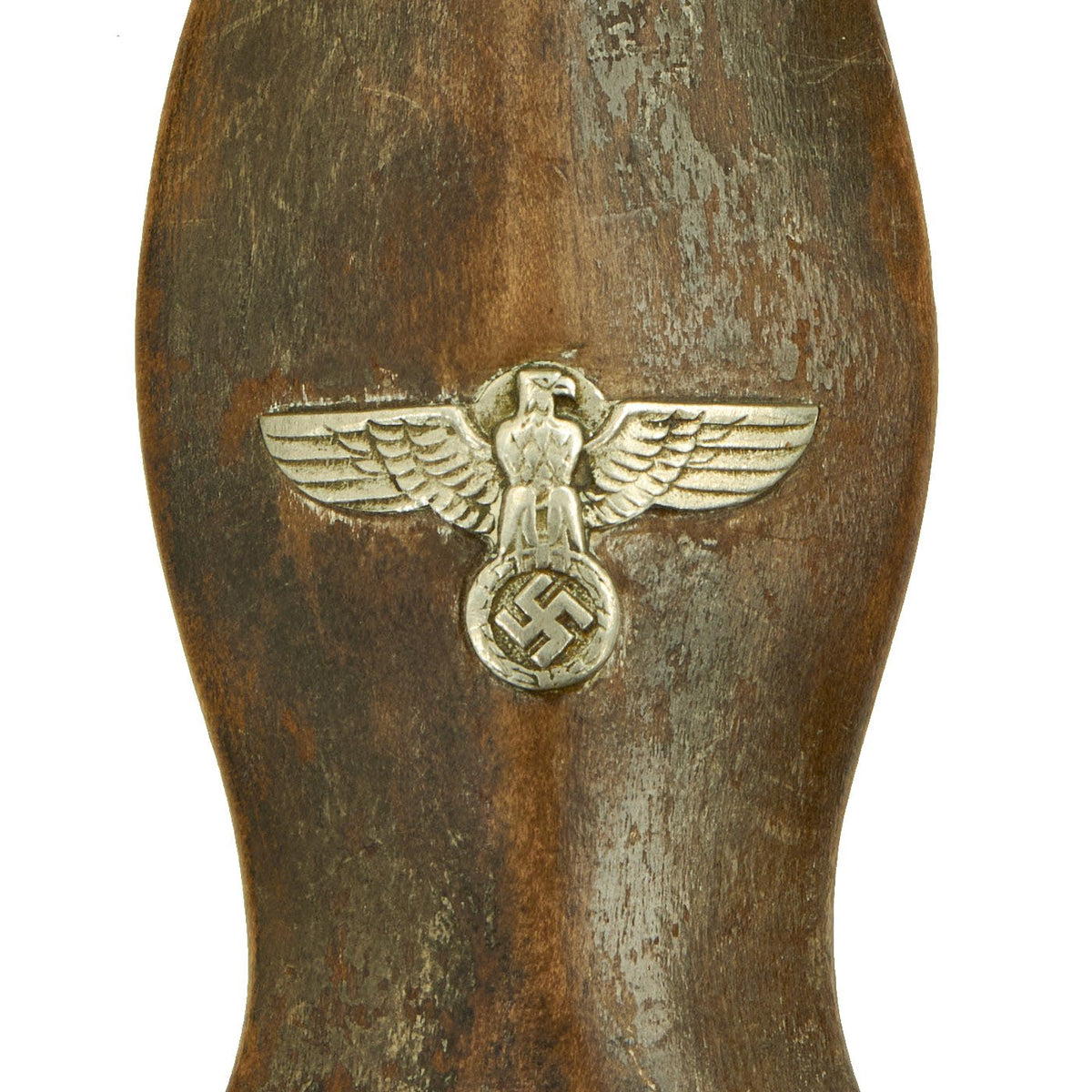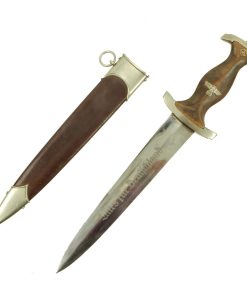Original German WWII Early SA Dagger by AESCULAP of Tuttlingen – Possible Ground Röhm Signature Original Items
$ 995,00 $ 248,75
Original Item: Only One Available. Prior to his “unmasking” as a traitor, Ernst Röhm was the leader of the Sturmabteilung (SA). In 1934, he distributed approximately 100,000 SA daggers with his personal inscription on the reverse blade. These daggers were to honor individuals who had served with the SA prior to December, 1931. Other than the inscription, these pieces were identical to the standard M1933 SA dagger. After the Röhm purge, the inscription was ordered to be removed, and failure to comply would be considered treason. Some were simply ground in the field by whatever means were available. Many other examples, as we suspect this is one of, were returned to the factory for grinding and refinishing. Examples will occasionally be encountered with remnants of the original inscription remaining on the blade, but mostly none will remain. Some blades exist with an intact inscription, exhibiting only the removal of the Röhm signature. Very, very rarely is an example seen with a full, untouched inscription, as the holder would have surely risked a charge of treason.
The front side of this blade is very nice, with some of the factory cross grain, and the usual runner wear. It does show polishing and cleaning, which has made the crossgrain faint, but in the light it is definitely there. The acid etched Alles für Deutschland motto is beautifully executed, though the factory darkening is mostly worn away. There are a few spots of past oxidation, which were polished out.
The rear of the blade looks to have been almost totally factory resurfaced, which has left only traces of the original signature, and a somewhat rough surface in areas. There is however still the etched trademark logo of Aesculap-Werke AG of Tuttlingen in Württemberg, a company that still exists today as a major maker of surgical instruments. Their logo is the well-known “S-form” serpent coiled around a ball-headed staff, the “Rod of Aesculapius”, the Greek God of medicine, under a crown. This trademark is on the back of the blade, surrounded by:
AESCULAP
(CROWN)
+ (Rod of Aesculapius) +
TUTTLINGEN
Per J. Anthony Carter’s book GERMAN KNIFE AND SWORD MAKERS, this firm was originally founded by Gottfried Jetter in 1867, and in 1887 he partnered with the Scheerer brothers to form Jetter & Scheerer. By 1895, they recognized the limitations of a family business, and formally incorporated. They built a new factory and registered the trademark Aesculap. The company used this particular “round” trademark on very early SA and NSKK daggers, which they made only made a small number of.
They were a known maker of the Röhm daggers, and we believe that we see a few spots of the original signature marking, though not enough to conclusively prove that it was originally signed. However, the evidence is definitely there.
The brown hardwood grip has no chips, cracks or major damage, just the usual wear to the finish from age and use. The solid nickel-silver eagle is crisp with a perfect fit, and just a bit of oxidation. The SA roundel also has a good fit and retains most of the enamel. The pommel and cross guard are fine solid nickel silver examples, still tight to the grip, with the expected wear from age and service. The pommel nut does show some evidence of tightening.
The lower reverse guard is Gruppe/Gau marked Sw, for Thuringen (Thuringia),f or Sudwest (South West) a district in far South West Germany, with the principal city being Stuttgart. This feature was only seen on daggers produced 1935 and prior.
The scabbard shell is straight throughout and is the early-war style, which were produced with a brown “anodized” finish on the steel, which was then lacquered. It still retains much of the original finish, with over 50% of the lacquer still remaining. This is definitely one of the better examples we have seen, with no dents on the body we can see, and lots of the original anodized finish intact. The upper and lower fittings are solid nickel silver, with a great look and some dents and scratches showing typical wear. The chape is lightly dented at the end, though not split, as the nickel alloy is somewhat soft, a common thing to see. The throat nicely matches the crossguards, and all fittings have their original dome headed screws.
A very interesting early SA dagger, marked by a rare maker and most likely “sanitized” after the Night of the Long Knives! Ready to add to your collection and display!
Specifications:
Blade Length: 8 3/4″
Overall length: 13 3/4”
Crossguard: 3”
Scabbard Length: 10”
The SA or Brown Shirts, were a private political formation which Adolf AH and the NSDAP used to maintain order at organized Party meetings and demonstrations. The group was formed in 1921, and grew to a huge force of nearly 3,000,000 men by the later 1930’s. To instill esprit de corps, as well as create employment for the Blade City of Solingen, it was decided each SA man would carry a dagger with his Brown Shirt uniform. Huge quantities needed to be produced to accommodate the demand. The dagger initially was produced of hand-fitted nickel mounts with attractive finished wood grip and brown anodized (a bluing process) finished scabbard.
The blade was etched with the SA motto, Alles für Deutschland. Examples produced prior to 1935 were stamped with the German sector of the SA group on reverse lower crossguard. Later examples underwent standardization through the RZM ministry. These pieces were produced of cheaper plated zinc-base fittings and scabbards were simply painted brown.
The Night of the Long Knives, in June 1934, saw the wiping out of the SA’s leadership and others who had angered AH in the recent past in NSDAP Germany. After this date, the SS lead by Heinrich Himmler was to become far more powerful in NSDAP Germany. For all the power the Enabling Act gave AH, he still felt threatened by some in the NSDAP Party. He was also worried that the regular army had not given an oath of allegiance. AH knew that the army hierarchy held him in disdain as he was ‘only ‘ a corporal in their eyes. The Night of the Long Knives not only removed the SA leaders but also got AH the army’s oath that he so needed.
By the summer of 1934, the SA’s numbers had swollen to 2 million men. They were under the control of Ernst Röhm, a loyal follower of AH since the early days of the NSDAP Party. The SA had given the NSDAP’s an iron fist with which to disrupt other political parties meetings before January 1933. The SA was also used to enforce law after AH became Chancellor in January 1933. To all intents, they were the enforcers of the NSDAP Party and there is no evidence that Röhm was ever planning anything against AH. However, Röhm had made enemies within the NSDAP Party – Himmler, Goering and Goebbels were angered by the power he had gained and convinced AH that this was a threat to his position. By June 1934, the regular army hierarchy also saw the SA as a threat to their authority. The SA outnumbered the army by 1934 and Röhm had openly spoken about taking over the regular army by absorbing it into the SA. Such talk alarmed the army’s leaders.
By the summer of 1934, AH had decided that Röhm was a ‘threat’ and he made a pact with the army. If Röhm and the other SA leaders were removed, the rank and file SA men would come under the control of the army but the army would have to swear an oath of loyalty to AH. The army agreed and Röhm’s fate was sealed. On the night of June 29th – June 30th 1934, units of the SS arrested the leaders of the SA and other political opponents. Men such as Gregor Strasser, von Schleicher and von Bredow were arrested and none of them had any connection with Röhm. The arrests carried on for 2 more nights. Seventy seven men were executed on charges of treason though historians tend to think the figure is higher. The SA was brought to heel and placed under the command of the army. AH received an oath of allegiance from all those who served in the army. Röhm was shot. Others were bludgeoned to death. The first the public officially knew about the event was on July 13th 1934, when AH told the Reichstag that met in the Kroll Opera House, Berlin, that for the duration of the arrests that he and he alone was the judge in Germany and that the SS carried out his orders. From that time on the SS became a feared force in NSDAP Germany lead by Heinrich Himmler. The efficiency with which the SS had carried out its orders greatly impressed AH and Himmler was to acquire huge power within NSDAP Germany.
Fast Shipping with Professional Packaging
Thanks to our longstanding association with UPS FedEx DHL, and other major international carriers, we are able to provide a range of shipping options. Our warehouse staff is expertly trained and will wrap your products according to our exact and precise specifications. Prior to shipping, your goods will be thoroughly examined and securely secured. We ship to thousands clients each day across multiple countries. This shows how we're dedicated to be the largest retailer on the internet. Warehouses and distribution centres can be located throughout Europe as well as the USA.
Note: Orders with more than one item will be assigned a processing date depending on the item.
Before shipping before shipping, we'll conduct a thorough inspection of the items you have ordered. Today, the majority of orders will be delivered within 48 hours. The delivery time will be between 3-7 days.
Returns
The stock is dynamic and we cannot completely manage it because multiple stakeholders are involved, including our factory and warehouse. So the actual stock may alter at any time. It's possible that you may not receive your order once the order has been made.
Our policy is valid for a period of 30 days. If you don't receive the product within 30 days, we are not able to issue a refund or an exchange.
You can only return an item if it is unused and in the same state as the day you received it. You must have the item in its original packaging.
Related products
Uncategorized
Uncategorized
Uncategorized
Uncategorized
Angolan Rebel 1970s era 60mm Inert Display Mortar from Angolan Civil War Original Items
Uncategorized
Armoured Fighting Vehicles of the World: AFVs of World War One (Hardcover Book) New Made Items
Uncategorized
Uncategorized
Uncategorized
Uncategorized
Uncategorized
Australian WWII Owen MK1 Machine Carbine SMG Custom Fabricated Replica with Sling Original Items
Uncategorized
Uncategorized
Uncategorized
Uncategorized
Uncategorized
Uncategorized
Uncategorized
Uncategorized
